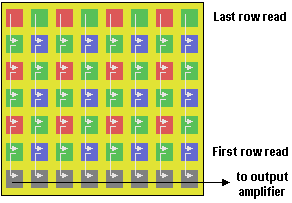The CCD is the technology at the heart of most digital cameras, and replaces both the shutter and film found in conventional cameras. Its origins lie in 1960s, when the hunt was on for inexpensive, mass-producible memory solutions. Its eventual application as an image-capture device hadn’t even occurred to the scientists working with the technology initially.
At Bell Labs in 1969, Willard Boyle and George Smith came up with the CCD as a way to store data. The first imaging CCD, with a format of 100×100 pixels, was created in 1974 by Fairchild Electronics. By the following year the device was being used in TV cameras for commercial broadcasts and soon became commonplace in telescopes and medical imaging systems. It was some time later before the CCD became part of the high-street technology that is now the digital camera.
It works like an electronic version of a human eye. Each CCD consists of millions of cells known as photosites or photodiodes. These are essentially light-collecting wells that convert optical information into an electric charge. When light particles known as photons enter the silicon body of the photosite, they provide enough energy for negatively-charged electrons to be released. The more light that enters the photosite, the more free electrons are available. Each photosite has an electrical contact attached to it, and when a voltage is applied to this the silicon below each photosite becomes receptive to the freed electrons and acts as a container for them. Thus, each photosite has a particular charge associated with it – the greater the charge, the brighter the intensity of the associated pixel.

The next stage in the process passes this current to what’s known as a read-out register. As the charges enter and then exit the read-out register they’re deleted and, since the charge in each row is coupled to the next, this has the effect of dragging the next in behind it. The signals are then passed – as free of signal noise as possible – to an amplifier and thence on to the ADC.
The photosites on a CCD actually respond only to light – not to colour. Colour is added to the image by means of red, green and blue filters placed over each pixel. As the CCD mimics the human eye, the ration of green filters to that of red and blue is two to one. This is because the human eye is most sensitive to yellow-green light. As a pixel can only represent one colour, the true colour is made by averaging the light intensity of the pixels around it – a process known as colour interpolation.
Recognising a glass ceiling in the conventional charge-coupled device (CCD) design, Fujifilm have developed a new, radically different CCD with larger, octagonal-shaped photosites situated on 45-degree angles in place of the standard square shape. This new arrangement is aimed at avoiding the signal noise that has previously placed limits on the densities of photosites on a CCD, providing improved colour reproduction, a wider dynamic range and increased sensitivity, all attributes that result in sharper, more colourful digital images.
- What is CCD in the Context of Digital Cameras?
- CMOS Digital Cameras
- What Controls The Picture Quality of a Digital Camera
- Features and Parts of a Digital Camera
- PIM Technology
- Digital Camera Batteries: Types and How They Work
- Memory Storage
- Storage of Photos and Videos on Digital Cameras
- Digital Camera Connectivity
- Digital Cameras vs. Film
- X3 Technology
- What is PictBridge and PTP?